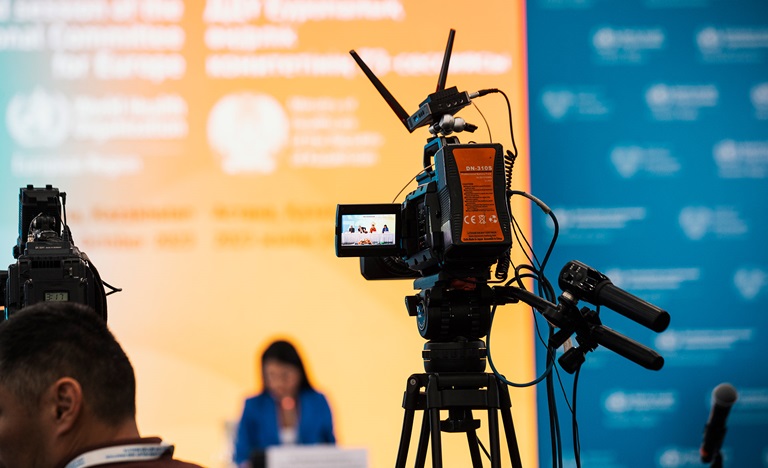
Newsroom
WHO / Uka Borregaard
©
Credits
Media Contacts
![]()
WHO/Europe Press Office
Email: eupress@who.int
Latest news
All →“Consult your doctor about antibiotics first”: using digital marketing to tackle antimicrobial resistance in Ukraine
Nov 18, 2021, 13:08 PM
Over-the-counter sales of antibiotics and their consequential misuse and overuse by consumers is a big challenge in Ukraine. Some people are unable or unwilling to see a doctor for medical advice, so they buy medicines such as antibiotics without a clear diagnosis and prescription.
Over-the-counter sales of antibiotics and their consequential misuse and overuse by consumers is a big challenge in Ukraine. Some people are unable or unwilling to see a doctor for medical advice, so they buy medicines such as antibiotics without a clear diagnosis and prescription.
Instead, they rely on their own perceived knowledge and experience or the advice of their family, friends, and neighbours. Some customers put pressure on pharmacists to sell them antibiotics over the counter without a doctor’s prescription.
Irrational use of antibiotics can lead to antimicrobial resistance (AMR). Resistance to antibiotics develops in the bacteria of an individual patient. From there they can spread to the surroundings and to other patients, potentially causing infections that are difficult to treat. Over time the spread of AMR in society renders many antibiotics, used to treat many common bacterial infections, ineffective.
Against this backdrop, the WHO Ukraine Country Office, in close collaboration with the Ukraine National Public Health Centre (PHC), set out to educate both health professionals and the public about correct antibiotic medication use through an awareness-raising campaign. The message was clear: prescription of antibiotics should be left to doctors, people should be encouraged not to self-medicate and pharmacists should be encouraged not to dispense antibiotics without a prescription.
The first audience targeted by the WHO Ukraine Country Office consisted of women aged 25–40 who are active internet users and often are their family’s health decision-makers. The second target audience, which is to be addressed in the next round of the project, consists of pharmacists and doctors of all ages, particularly paediatricians and general practitioners. These two audiences account for approximately 3 million people in Ukraine, or almost 7% of the country’s total population.
“You can reach your target audiences almost immediately with digital tools”
The WHO Ukraine Country Office decided that the most effective way to reach its target audiences and achieve its objectives and goals would be through a digital educational campaign. “We decided to create and carry out a digital campaign rather than a traditional PR campaign. In today’s world it is important to reach people through the channels they use, rather than with posters and brochures. You can reach your target audiences almost immediately with digital tools,” says Jarno Habicht, WHO Representative in Ukraine. “We quickly developed a digital ecosystem consisting of a website, a Facebook page, and a YouTube channel in early 2020.”
The website displays the myriad bacteria in the world and informs readers about antibiotics, their purpose, and their proper and safe use. Additionally, the campaign created a series of fun videos hosted on its YouTube channel to show the variety of bacteria species and explain their sometimes very strange names. Finally, the Facebook page posted graphics that contained facts and news about antibiotics and referred readers back to the website. The campaign materials were also promoted via the Facebook pages of both the Ministry of Health and the PHC.
The website launched in February 2020. To attract a wide audience to the website, the campaign employed digital marketing tools such as banners on the Google Display Network, social media marketing, and Google AdWords. To illustrate how the last of these worked, if someone searched for “antibiotics” or “antimicrobial resistance” on Google’s Ukraine page, the campaign website would be at the top of the search results. Users would therefore be more likely to visit the website.
Analytics show the campaign made an impact
Analytics showed that over 78% of visits to the website were by women 25–44 years old, which matched the first of the two target audiences (the use of the webpage by health professionals among the users has not yet been evaluated). Because the search campaign did not specifically target women, the congruence between the campaign’s target audience and the real-world website audience confirms that the approach used worked well for the expected target audience.
The campaign used various metrics to measure its performance and to make any necessary adjustments. Metrics included the number of clicks from banners, videos, social networks, and search ads, the amount of time spent on the website, the number of pages viewed, the percentage of a video watched, as well as the level of awareness growth among the contacted audience.
The most popular pages were “How antibiotics work” and “Why bacteria are winning”. The average duration of those page visits was 14–15 minutes and 75% of the users scrolled at least 50% of the articles. This means visitors to the website were very engaged.
A major step forward for the future of the campaign is that the PHC took ownership of the campaign platform. “The WHO Ukraine Country Office, in cooperation with the PHC, did a great job at establishing a strong digital ecosystem, reaching the target audiences, targeting the right audiences, and setting the stage for behaviour change. We look forward to building on this work, engaging other groups, and helping to win the battle against AMR,” said Oleksandr Matskov, deputy director of the PHC.




